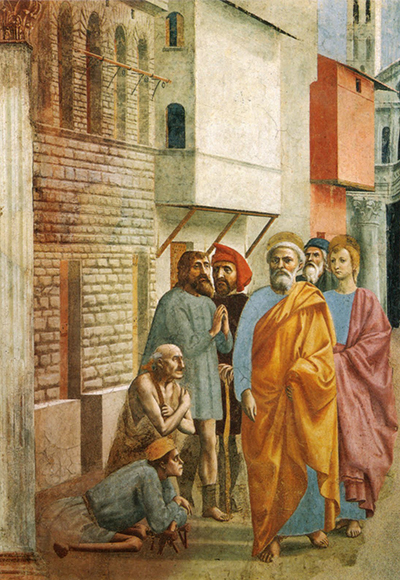The electorate artwork belongs to the work of the Early Renaissance artist, Masaccio.
The story within the photo to the left belongs to a scripture in the Catholic bible in the Acts of the Apostles.
The story depicted within the mural occurs immediately after the story of Ananias, as St. PeterÕs presence heals the sick. Masaccio had previously depicted the history of Ananias within his artwork titled Distribution of Alms and the Death of Ananias.
The painting of St. Peter is an Italian fresco, and was painted as an altarpiece as many of MasaccioÕs work usually was created for. The painting illustrates the captivating presence of St. Peter as his own shadow holds the power to heal the sick.
Within the painting, the Saint simply walks along a street as the sick halt to the side and praise his grace. The fascinating symbol behind the artwork is the serious facial expression St. Peter is seized with as he seems to not even witness the sick and walks forward on. Yet, while the gospel story analyzes the event in more detail and the delicate interaction of St. Peter and the poor, Masaccio depicts the Saint as he if walks past the people without acknowledging their presence.
It is a significant question to wonder as to why Masaccio had showcased the St. Peter as if he holds contempt for others within the artwork. It is also interesting to note that the apostles who walk behind him stare at the same focal point as St. Peter, not looking at the poor as well.
As evident through the title, the shadow of St. Peter is prominent enough to heal the sick on its own. As the holy entity walks by the people, his internal spirit grants those around him back to health as they feel his presence upon them.
Masaccio created an interesting balance between the artwork; as St. Peter seems as if he does not acknowledge the sick near him, his shadow illustrates his religious principles and their natural power to heal those around him.
The Saint is dressed in an orange shall that covers half of his chest then flows towards the floor. Beneath he is dressed in a blue fabric that seems to simply wrap his body. Behind him, a female woman is showcased following in his footsteps, however is illustrated to also be a Saint as an aurora is constructed around her head. Masaccio often did this characteristic within his artwork in order to be able to distinguish Saints and holy figures within his artwork.
Two more colorful figures seem to be following the two Saints, a man in a red hat and a man to his left in a teal hat. It seems as if these figures seem to acknowledge the sick and act towards them on St. PeterÕs behalf.
Of the three characters titled as the sick, one man stands with his hands in the shape of a cross as he praises St. Peter. The man next to him is showcased as an old man knelling as he folds his arms into the sign of the cross asking for a blessing, as he is a sinner. The last figure is a woman on the floor who resembles a circle looking up at St. Peter.
As St. Peter's presence is meant to heal these people as they walk by, it seems as if a domino effect occurs as the sick slowly begin to stand up as they are healed. The artwork showcases a dispute of emotions and viewpoints towards the artwork, yet secures the main idea that these individuals praise St. Peter.




